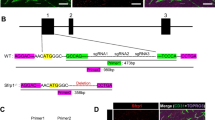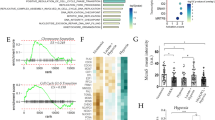Abstract
Objective
Lymphatic endothelial cell (LEC) proliferation is essential for lymphangiogenesis. Hypoxia induces lymphangiogenesis, but it directly inhibits LEC proliferation and the underlying mechanisms have not been fully understood. The aim of this study was to investigate the role of carcinoembryonic antigen-related cell adhesion molecule 1 (CEACAM1) in hypoxia-repressed LEC proliferation.
Methods
Human dermal lymphatic endothelial cells (HDLECs) were cultured under normoxic or hypoxic conditions, and cell proliferation was determined using MTT or CCK-8 assays. CEACAM1 expression was silenced by siRNA transfection. Activation of mitogen-activated protein kinases (MAPKs) was examined by Western blotting and blocked by specific inhibitors.
Results
Under hypoxia, HDLECs proliferation was suppressed and CEACAM1 expression was downregulated. Silence of CEACAM1 in normoxia inhibited HDLECs proliferation and did not further decrease proliferation in HDLECs in response to hypoxia, suggesting that CEACAM1 may mediate hypoxia-induced inhibition of HDLECs proliferation. In addition, silence of CEACAM1 increased phosphorylation of MAPK molecules: extracellular signal-regulated kinase (ERK), p38 MAPK and Jun N-terminal kinase (JNK) in HDLECs. However, only inhibition of the JNK pathway rescued the reduction of HDLEC proliferation induced by CEACAM1 silence.
Conclusion
Our results suggested that hypoxia downregulates CEACAM1 expression by activation of the JNK pathway, leading to inhibition of HDLEC proliferation. These findings may help to understand the mechanisms of LEC-specific response to hypoxia and develop novel therapies for pathological lymphangiogenesis.
Similar content being viewed by others

References
Ji RC. Macrophages are important mediators of either tumor- or inflammation-induced lymphangiogenesis. Cell Mol Life Sci, 2012,69(6):897–914
Stacker SA, Williams SP, Karnezis T, et al. Lymphangiogenesis and lymphatic vessel remodelling in cancer. Nat Rev Cancer, 2014,14(3):159–172
Alitalo K, Tammela T, Petrova TV. Lymphangiogenesis in development and human disease. Nature, 2005,438(7070):946–953
Tammela T, Alitalo K. Lymphangiogenesis: Molecular mechanisms and future promise. Cell, 2010,140(4):460–476
Sormendi S, Wielockx B. Hypoxia Pathway Proteins As Central Mediators of Metabolism in the Tumor Cells and Their Microenvironment. Front Immunol, 2018,9:40
Semenza G L. Cancer-stromal cell interactions mediated by hypoxia-inducible factors promote angiogenesis, lymphangiogenesis, and metastasis. Oncogene, 2013,32(35):4057–4063
Alitalo K, Carmeliet P. Molecular mechanisms of lymphangiogenesis in health and disease. Cancer Cell, 2002,1(3):219–227
Ma C, Liu Y, Wang Y, et al. Hypoxia activates 15-PGDH and its metabolite 15-KETE to promote pulmonary artery endothelial cells proliferation via ERK1/2 signalling. Br J Pharmacol, 2014,171(14):3352–3363
Irigoyen M, Anso E, Martinez E, et al. Hypoxia alters the adhesive properties of lymphatic endothelial cells. A transcriptional and functional study. Biochim Biophys Acta, 2007,1773(6):880–890
Xie Q, Chen X, Xu Y, et al. CEACAM1 resists hypoxia-induced inhibition of tube formation of human dermal lymphatic endothelial cells. Cell Signal, 2018,45:145–152
Gray-Owen SD, Blumberg RS. CEACAM1: contact-dependent control of immunity. Nat Rev Immunol, 2006,6(6):433–446
Nouvion AL, Oubaha M, Leblanc S, et al. CEACAM1: a key regulator of vascular permeability. J Cell Sci, 2010,123(Pt 24):4221–4230
Kilic N, Oliveira-Ferrer L, Neshat-Vahid S, et al. Lymphatic reprogramming of microvascular endothelial cells by CEA-related cell adhesion molecule-1 via interaction with VEGFR-3 and Prox1. Blood, 2007,110(13):4223–4233
Singer BB, Klaile E, Scheffrahn I, et al. CEACAM1 (CD66a) mediates delay of spontaneous and Fas ligand-induced apoptosis in granulocytes. Eur J Immunol, 2005,35(6):1949–1959
Greicius G, Severinson E, Beauchemin N, et al. CEACAM1 is a potent regulator of B cell receptor complex-induced activation. J Leukoc Biol, 2003,74(1):126–134
Gerstel D, Wegwitz F, Jannasch K, et al. CEACAM1 creates a pro-angiogenic tumor microenvironment that supports tumor vessel maturation. Oncogene, 2011,30(41):4275–4288
Li L, Dong F, Xu D, et al. Short-term, low-dose cadmium exposure induces hyperpermeability in human renal glomerular endothelial cells. J Appl Toxicol, 2016,36(2):257–265
Cheng DD, Zhu B, Li SJ, et al. Down-regulation of RPS9 Inhibits Osteosarcoma Cell Growth through Inactivation of MAPK Signaling Pathway. J Cancer, 2017,8(14):2720–2728
Ernens I, Lumley AI, Zhang L, et al. Hypoxia inhibits lymphatic thoracic duct formation in zebrafish. Biochem Biophys Res commun, 2017,482(4):1129–1134
Ji RC. Hypoxia and lymphangiogenesis in tumor microenvironment and metastasis. Cancer Lett, 2014,346(1):6–16
Wei T, Jia J, Wada Y, et al. Dose dependent effects of cadmium on tumor angiogenesis. Oncotarget, 2017,8(27):44 944–44 959
Morfoisse F, Renaud E, Hantelys F, et al. Role of hypoxia and vascular endothelial growth factors in lymphangiogenesis. Mol Cell Oncol, 2015,2(4):e1024821
Horst A K, Ito W D, Dabelstein J, et al. Carcinoembryonic antigen-related cell adhesion molecule 1 modulates vascular remodeling in vitro and in vivo. J Clin Invest, 2006,116(6):1596–1605
Zhang J, Guo L, Zhou X, et al. Dihydroartemisinin induces endothelial cell anoikis through the activation of the JNK signaling pathway. Oncology Lett, 2016,12(3):1896–1900
Chen X, Xu Y, Cheng Z, et al. Low-dose cadmium activates the JNK signaling pathway in human renal podocytes. Int J Mol Med, 2018,41(4):2359–2365
Author information
Authors and Affiliations
Corresponding author
Additional information
Conflict of Interest Statement
The authors declare that they have no competing interests.
This study was supported by grants from the National Natural Science Foundation of China (No. 81873473 and No. 91939110), Academic Promotion Program of Shandong First Medical University (No. 2019QL014), and Shandong Taishan Scholarship (Ju Liu).
Electronic Supplementary Material
Rights and permissions
About this article
Cite this article
Xie, Q., Shang, Ty., Feng, S. et al. Hypoxia Inhibits Proliferation of Human Dermal Lymphatic Endothelial Cells via Downregulation of Carcinoembryonic Antigen-related Cell Adhesion Molecule 1 Expression. CURR MED SCI 41, 1192–1197 (2021). https://doi.org/10.1007/s11596-021-2448-5
Received:
Accepted:
Published:
Issue Date:
DOI: https://doi.org/10.1007/s11596-021-2448-5



